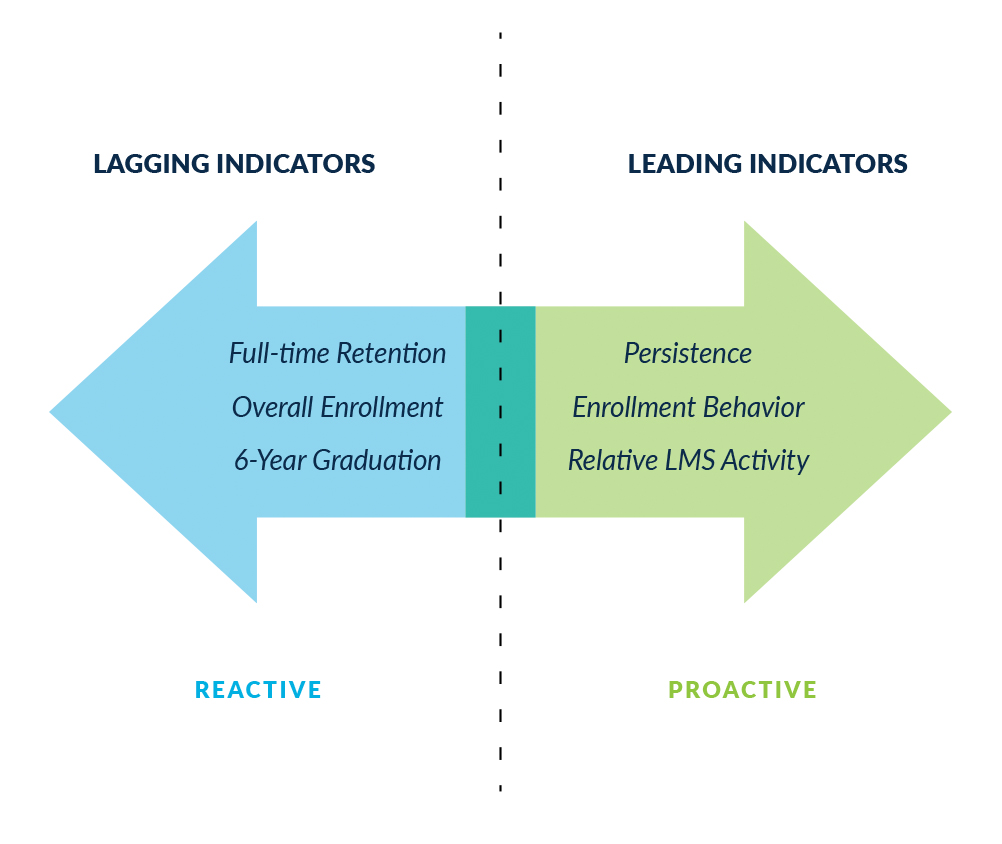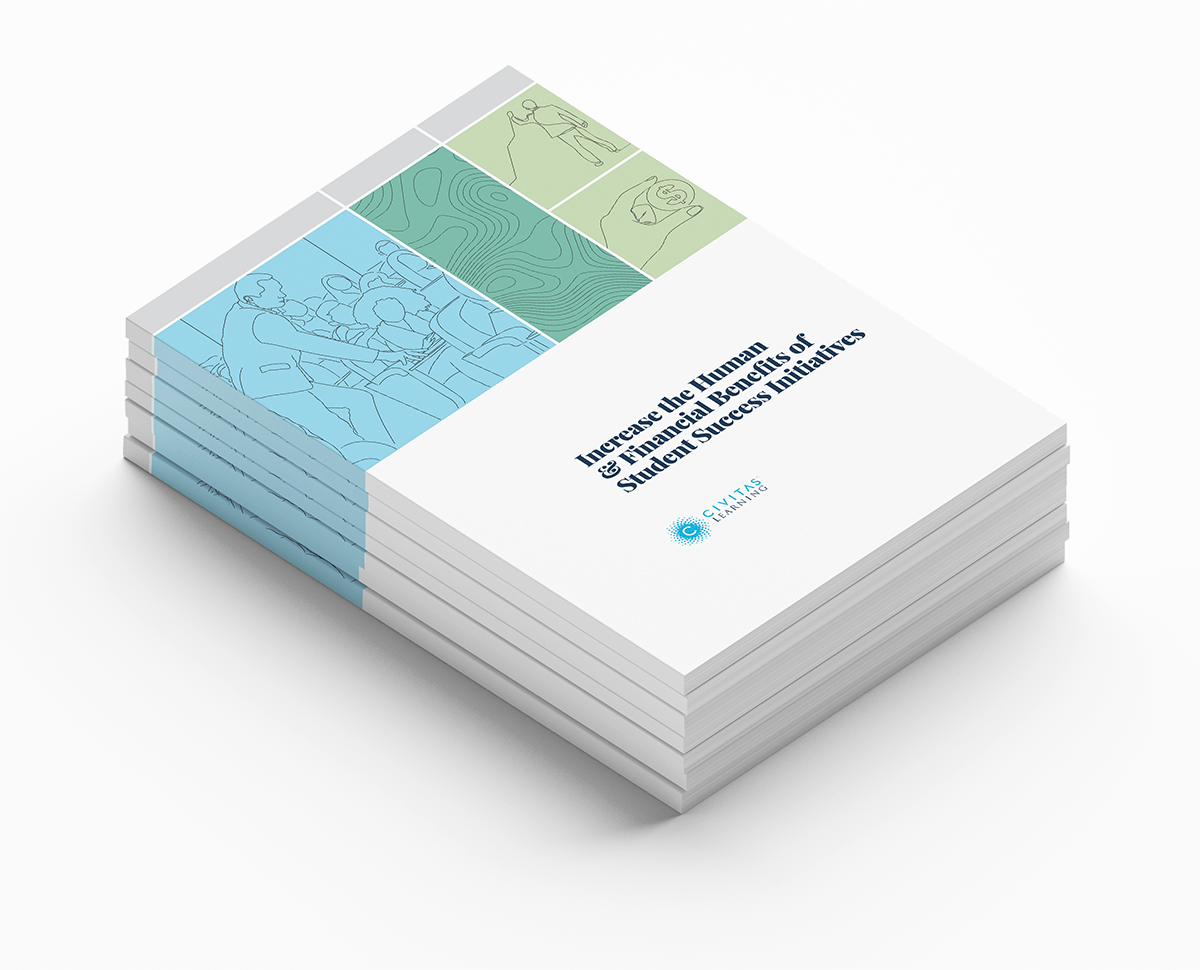
Why It’s Essential to Use Persistence as a Student Success Metric
Share this Post
As you well know, supporting students as they work to achieve their academic goals is not straightforward. Over the last decade, colleges and universities have responded to increasing internal and external pressures to improve student outcomes by implementing various student success initiatives. Knowing which practices improve student outcomes and institutional goals are still challenging despite these focused efforts.
Enrollment, retention, and six-year graduation rates have become the standard way to measure the effectiveness of student success approaches. While these metrics are helpful for long-term planning and assessment of overall institutional effectiveness, they’re not great diagnostic tools.
To improve student outcomes, leaders like you need metrics to help determine which students need support now. Access to actionable insight around what works for specific student groups and who needs that help today empowers you to make shorter-term, strategic adjustments to programs and team coordination. This gives you time to positively influence the enrollment of continuing students and impact net tuition revenue within each semester.
Without persistence, retention and graduation rates fall short of providing the necessary insights leaders need to successfully calibrate success strategies to the real-time needs of students.
When higher ed leaders hone in on persistence as a success metric, they unlock a powerfully dynamic indicator their teams can use in daily work to effectively and efficiently support students. Evaluating how programs impact persistence leads to a better understanding of the effectiveness of student success programs. Clarifying which initiatives drive positive student outcomes leads to more proactive and effective student support.
To scale effective student success strategies with limited resources, institutions must adopt an approach that focuses on the return on investment of student success programs. Including persistence as an evaluation, metric is essential to an ROI-driven approach to student success.
Monitoring Persistence Makes Proactive Support More Feasible
Despite their best efforts, institutions that rely solely on retention and graduation rates to plan student success initiatives may never achieve a proactive approach to student success because their focus on lagging indicators perpetuates reactive strategies.
The likelihood of students achieving their academic goals fluctuates over time, regardless of academic history or demographic characteristics. An analysis of Civitas Learning partner institutions revealed that 39% of students’ likelihood to persist changes within a single semester. To identify students needing support while there’s still time to make a difference, advising and student success staff require access to data as dynamic as the challenges students face.
Persistence predictions updated throughout the semester with in-progress academic and behavioral data, such as a student’s relative LMS activity, provide a more accurate and dynamic depiction of a student’s academic risk than predictive models that rely solely on historical and demographic data. While these data provide helpful background information, they fail to deliver real-time insights that enable advisors to tailor their outreach efforts and provide “just-in-time” support that changes student outcomes and supports re-enrollment.
To break free of reactive student support strategies, institutions must emphasize leading indicators of success, such as the likelihood to persistence, rather than lagging indicators like retention and graduation rates. Incorporating real-time academic and behavioral data into prediction models ensures that advising staff is equipped with diagnostic tools that facilitate proactive outreach and support.
Using Persistence to Pinpoint Initiatives that Boost Enrollment and Net Tuition Revenue
It isn’t easy to account for all variables affecting student success when measuring support programs with the standard enrollment, retention, and graduation metrics. Events beyond the institution’s control can impact enrollment and retention. Graduation rates can take years to change. Evaluation methods that don’t control selection bias or compare mismatched groups can result in skewed assessment results, misinforming strategic decisions.
While retention and graduation rates offer macro-level insights about how well an institution supports students, persistence provides more immediate visibility into which programs directly influence re-enrollment and contribute to net tuition revenue each semester. Understanding student success initiatives’ return on investment enables institutions to adjust strategies more readily and reallocate resources to the most effective programs.

A Civitas Learning analysis of over 1000 student success initiatives found that forty percent of student success initiatives have no measurable impact on persistence to graduation, and 20% of initiatives that are effective in helping students overall don’t work for specific student groups. Without that ability to know what works and for whom, institutions may continue initiatives that deplete human and financial resources and miss opportunities to help students.
In today’s resource-constrained environment, campus leaders need to be able to act more immediately to impact student outcomes and positively influence the enrollment of continuing students. Without persistence, retention and graduation rates fall short of providing the necessary insights leaders need to calibrate success strategies to the real-time needs of students successfully.
Actionable Insights Lead to Strategic Decisions that Support Students and Institutions
Persistence is a powerful leading indicator. It helps institutions adopt an ROI-driven approach to student success to ensure that every practice supports the enrollment of continuing students and the institution’s financial sustainability.
Understanding how a student’s likelihood to persist changes throughout the term empowers student success teams to provide just-in-time support that drives improved student outcomes. Evaluating how student success initiatives affect persistence offers more immediate and actionable insights that campus leaders can use to adjust strategies and reallocate resources. This gives them the knowledge to achieve the most effective and efficient combination of programs and interventions.



